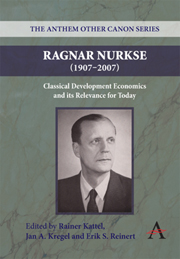Book contents
- Frontmatter
- Contents
- Preface
- Title in the series
- 1 The Relevance of Ragnar Nurkse and Classical Development Economics
- 2 Life and Time of Ragnar Nurkse
- 3 Nurkse and the Role of Finance in Development Economics
- 4 Early Development Theory from Sun Yat-sen to Ragnar Nurkse
- 5 The Roots of Unequal Exchange: Mihail Manoilescu and the Debate of the 1930s
- 6 Nurkse and the Early Latin American Structuralists: A Reflection on Development Theory, Industrialization and their Relevance Today
- 7 Lewis, the Long Wave and Industrialization in the Periphery
- 8 Ragnar Nurkse and the Law & Economics of Development
- 9 Ragnar Nurkse's Development Theory: Influences and Perceptions
- 10 Nurkse meets Schumpeter: Is Microfinance a ‘Silver Bullet’ to Economic Development?
- 11 Stockpiling of International Reserves and Development: a Misguided Link
- 12 International Currency Experience and the Bretton Woods System: Ragnar Nurkse as Architect
- 13 Some Reflections on Nurkse's Patterns of Trade and Development
- 14 India and Development Economics: External Influences and Internal Responses
- Notes
11 - Stockpiling of International Reserves and Development: a Misguided Link
Published online by Cambridge University Press: 05 March 2012
- Frontmatter
- Contents
- Preface
- Title in the series
- 1 The Relevance of Ragnar Nurkse and Classical Development Economics
- 2 Life and Time of Ragnar Nurkse
- 3 Nurkse and the Role of Finance in Development Economics
- 4 Early Development Theory from Sun Yat-sen to Ragnar Nurkse
- 5 The Roots of Unequal Exchange: Mihail Manoilescu and the Debate of the 1930s
- 6 Nurkse and the Early Latin American Structuralists: A Reflection on Development Theory, Industrialization and their Relevance Today
- 7 Lewis, the Long Wave and Industrialization in the Periphery
- 8 Ragnar Nurkse and the Law & Economics of Development
- 9 Ragnar Nurkse's Development Theory: Influences and Perceptions
- 10 Nurkse meets Schumpeter: Is Microfinance a ‘Silver Bullet’ to Economic Development?
- 11 Stockpiling of International Reserves and Development: a Misguided Link
- 12 International Currency Experience and the Bretton Woods System: Ragnar Nurkse as Architect
- 13 Some Reflections on Nurkse's Patterns of Trade and Development
- 14 India and Development Economics: External Influences and Internal Responses
- Notes
Summary
Introduction
The economic policy response to prevent the cycle of speculative attack-capital, flight-financial crisis, adopted by both crisis-affected and other non-affected emerging economies since Mexico's 1994–95 financial crisis, but particularly since the 1997–98 East Asian crisis, has been simply to increase liquidity through the accumulation of international reserves. Developing countries' international reserves ‘have risen from 6–8 per cent of GDP during the 1970s and 1980s to almost 30 per cent of GDP by 2004’ (Rodrik, 2006, 255). Furthermore, today, around two-thirds of international reserves are held by developing countries (Aizenman, 2007).
The dominant explanation for the build-up of reserves is that it simply represents precautionary behaviour designed to provide insurance against the high output and other costs associated with earlier crises. Countries following this strategy are evidently hoping to emulate those economies that escaped speculative attacks and/or capital flight (e.g., Chile, Columbia, China and India) and maintained policy autonomy, thereby providing ‘a way of reducing the risks of future crises and of minimizing the need to turn to the IMF if crises occurred’ (Bird and Mandilaras, 2005, 85). A second, alternative but not exclusive, explanation for reserves accumulation identifies it with an active policy of export-led industrialization characteristic of several countries in East Asia (especially China). This is the mercantilist interpretation of reserve accumulation, in which increased reserves are a by-product of maintaining a competitive exchange rate designed to expand tradeable production (see Aizenman and Riera-Critchton, 2006).
- Type
- Chapter
- Information
- Ragnar Nurkse (1907–2007)Classical Development Economics and its Relevance for Today, pp. 245 - 266Publisher: Anthem PressPrint publication year: 2009



